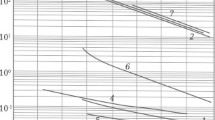Abstract
The advantages of melting refractory borosilicate glasses in electric furnaces as compared to gas furnaces are described. The processes that occur in liquid glass melted in deep electric furnaces and technologies producing liquid glass of high quality are considered.
Similar content being viewed by others
References
A. P. Sivko, “Mechanized production of the shells of high-pressure gas discharge bulbs,”Svetotekhnika, No. 7-8, 19–21 (1992).
A. P. Sivko, “Special features of melting borosilicate glasses in continuous furnaces,”Steklo Keram., No. 11, 18–19 (1987).
A. P. Sivko and I. P. Khil’chenko, “Special features of melting of refractory high-viscosity glass in electric furnaces,”Steklo Keram., No. 8, 23–25 (1989).
Author information
Authors and Affiliations
Additional information
Translated from Steklo i Keramika, No. 2, pp. 6–8, February, 1998.
Rights and permissions
About this article
Cite this article
Lityushkin, V.V., Sivko, A.P., Mikhailenko, N.Y. et al. Melting refractory borosilicate glass in electric furnaces. Glass Ceram 55, 36–38 (1998). https://doi.org/10.1007/BF03180143
Issue Date:
DOI: https://doi.org/10.1007/BF03180143




